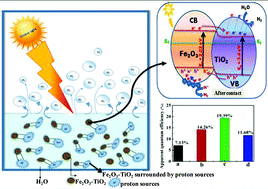Exploration and evaluation of proton source-assisted photocatalyst for hydrogen generation†
Abstract
The present paper reports about the superior performance of some amine-based proton sources in enhancing the photocatalytic efficiency of Fe2O3–TiO2 composite during a water-splitting reaction. The band gap of the Fe2O3–TiO2 catalyst is tuned to 2.3 eV by varying the Fe content. The heterojunctions generated in the photocatalyst facilitate effective charge carrier migration suppressing the electron–hole recombination rate. The enhanced photocatalytic activity of the catalyst is studied using an experimental setup comprising a solar simulator (AAA) and a hydrogen gas chromatograph. The effect of proton sources viz, aniline hydrogen chloride (AH), diethylamine hydrogen chloride (DAH) and triethylamine hydrogen chloride (TAH), on the photocatalytic performance of the catalyst is explored and studied in detail. These proton sources serve as electron donors that stimulate photogenerated electron–hole separation that results in high quantum efficiency of the Fe2O3–TiO2 photocatalyst. A very high hydrogen generation rate of 880 μmol h−1 is achieved with the DAH-assisted Fe2O3–TiO2, whereas it is just 323 μmol h−1 with the Fe2O3–TiO2 alone. The enhancement in the hydrogen generation rate is attributed to the high basic nature, distinct hole scavenging action, low electron–hole recombination rate and the swift interfacial charge – transfer process. The effect of other proton source-assisted catalysts are also discussed in detail.



 Please wait while we load your content...
Please wait while we load your content...